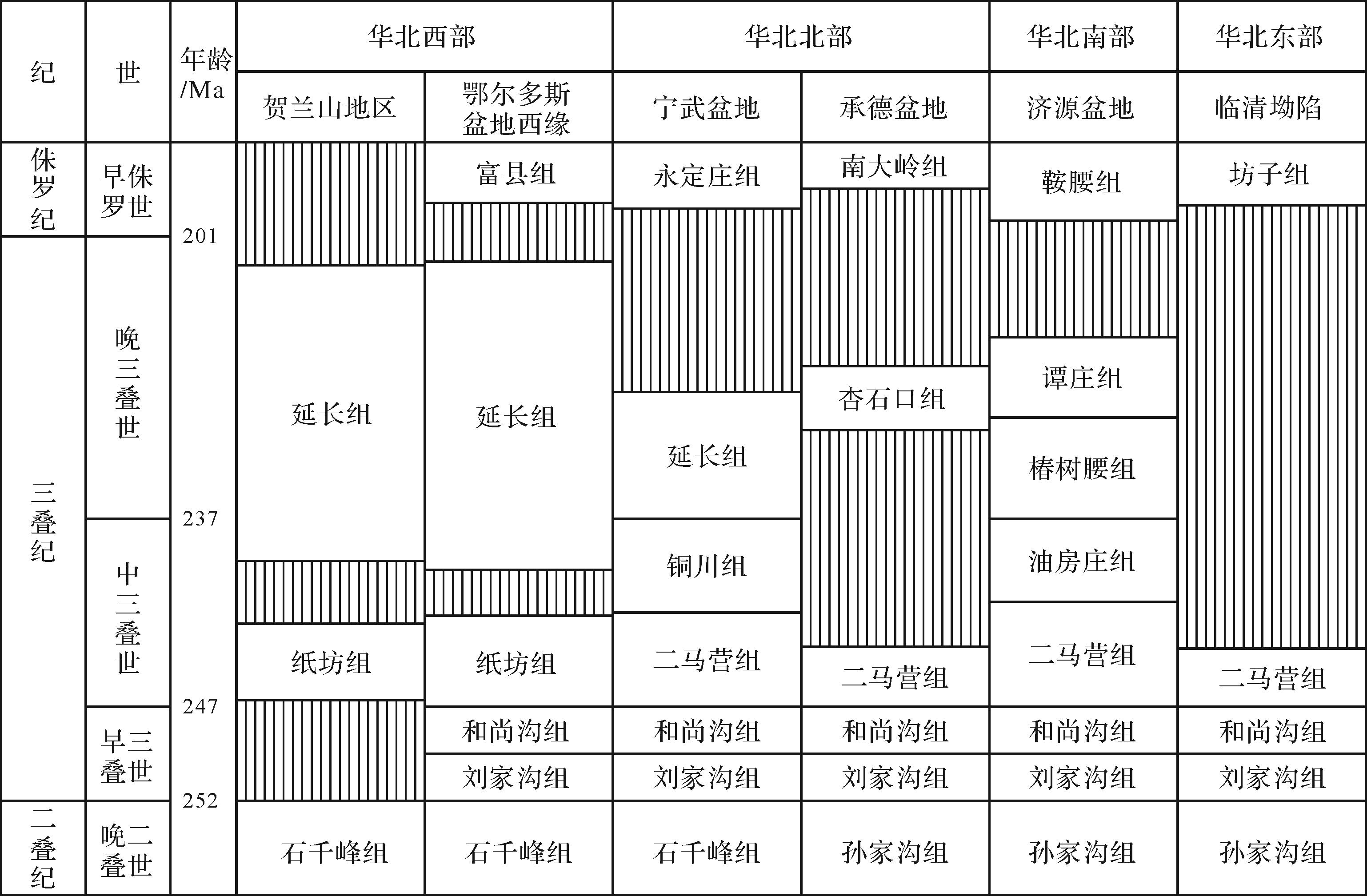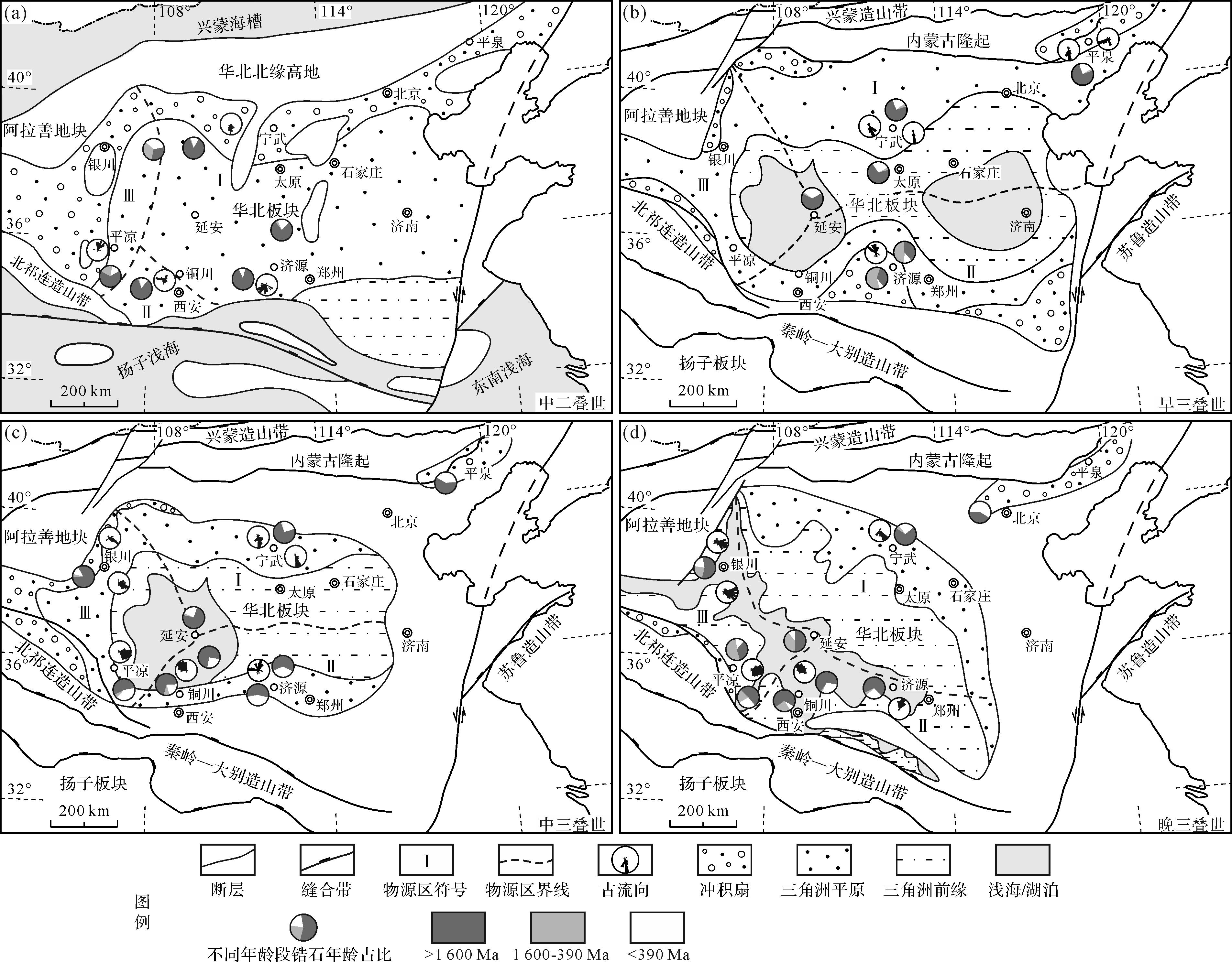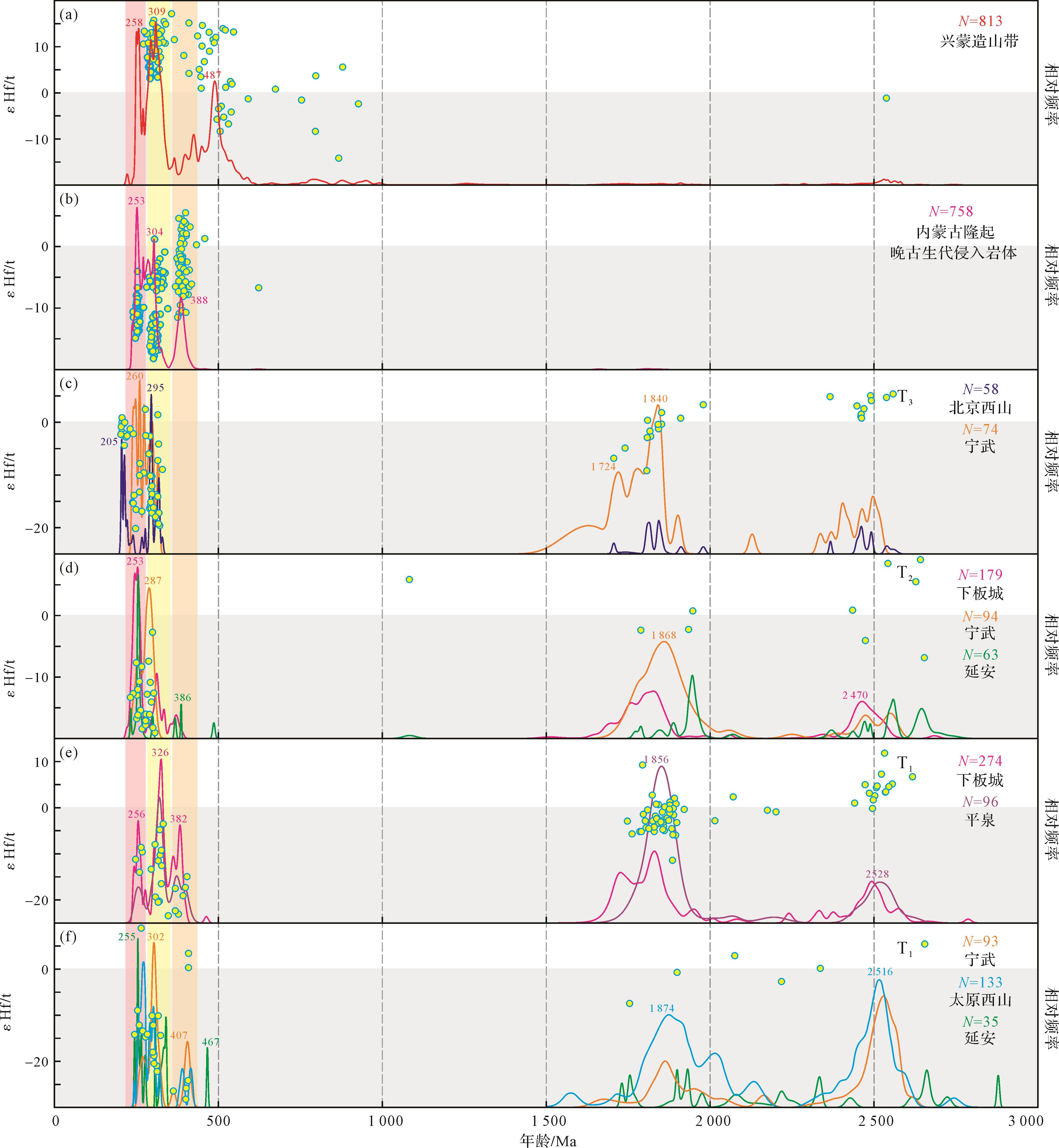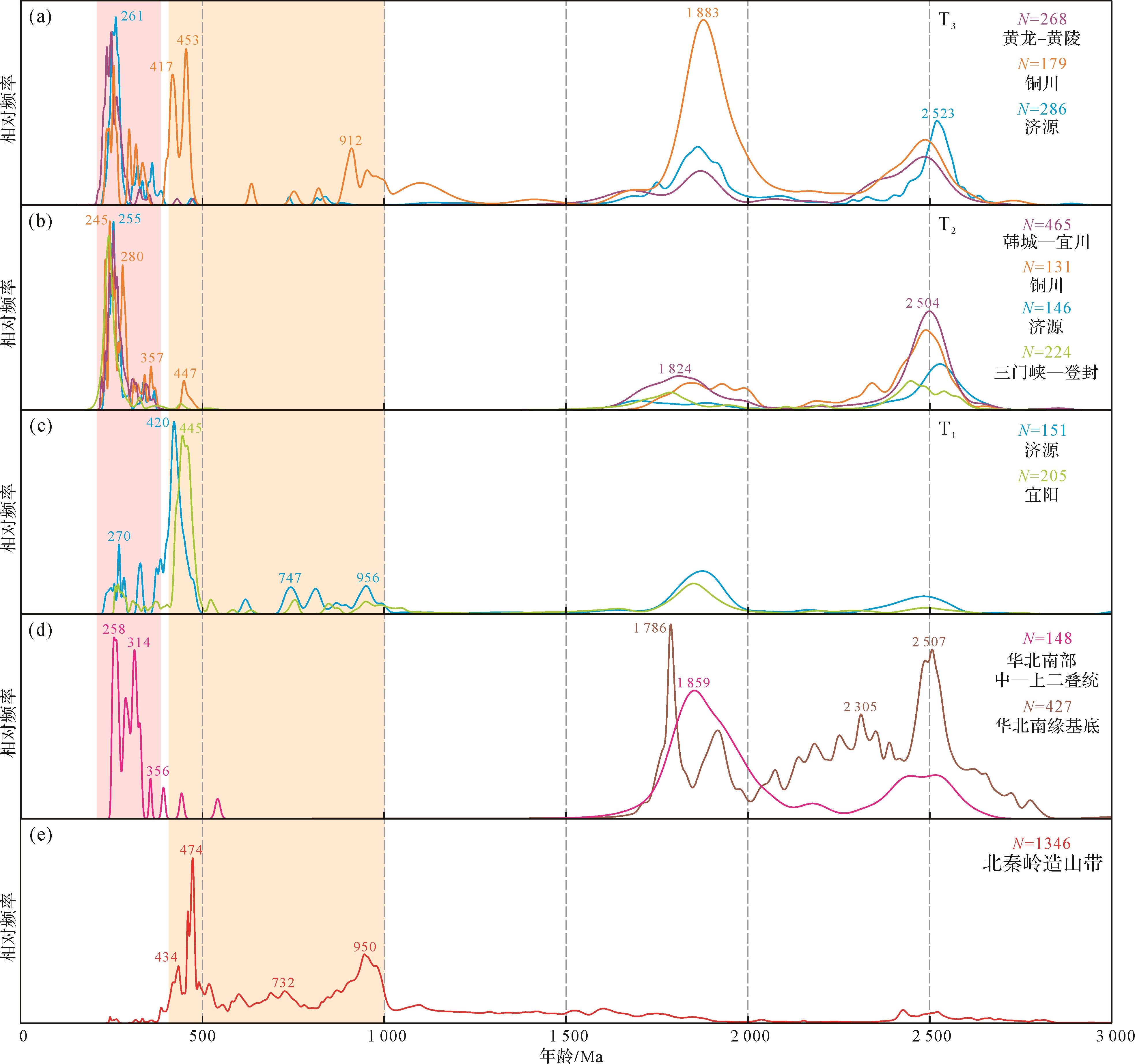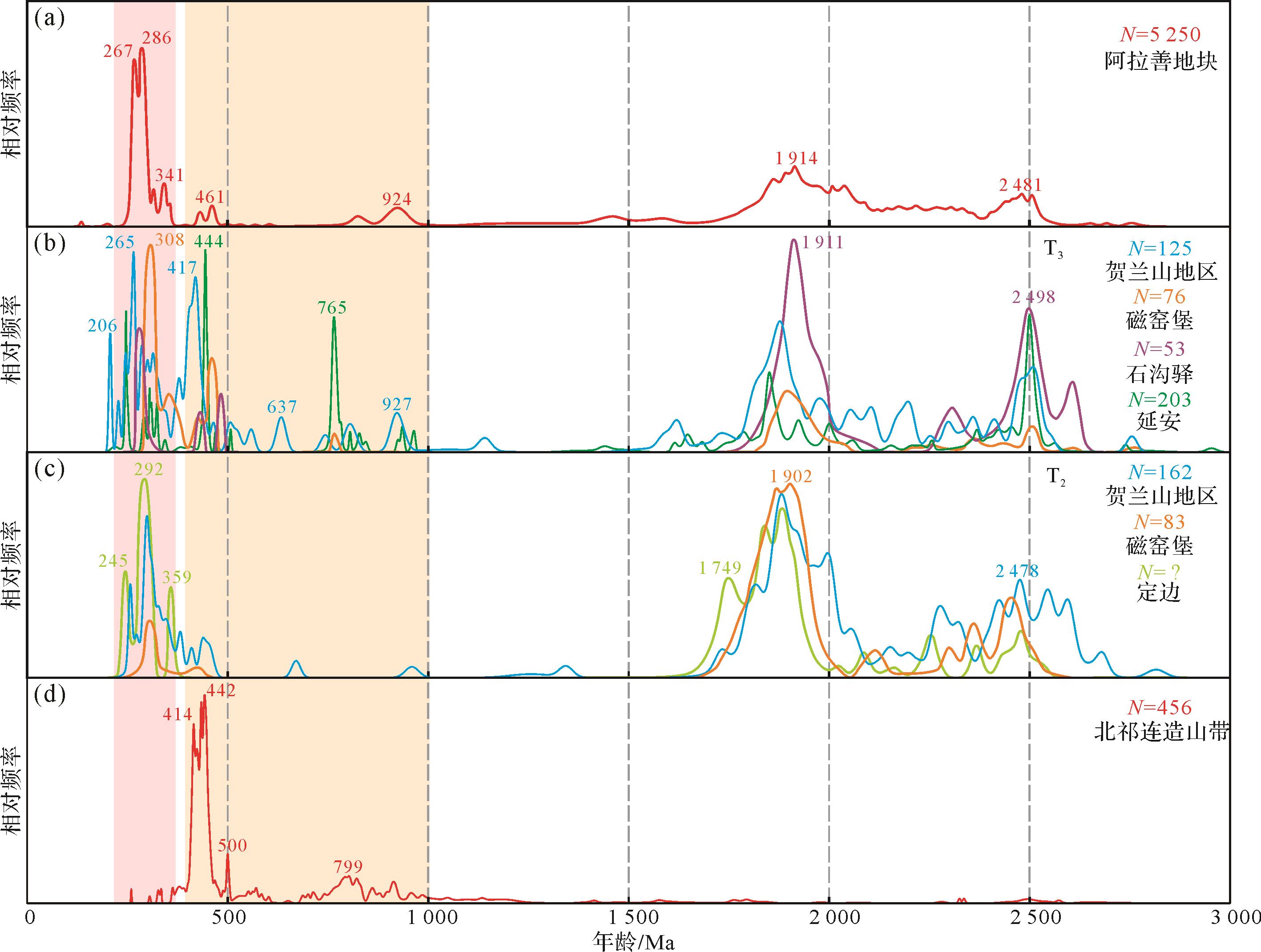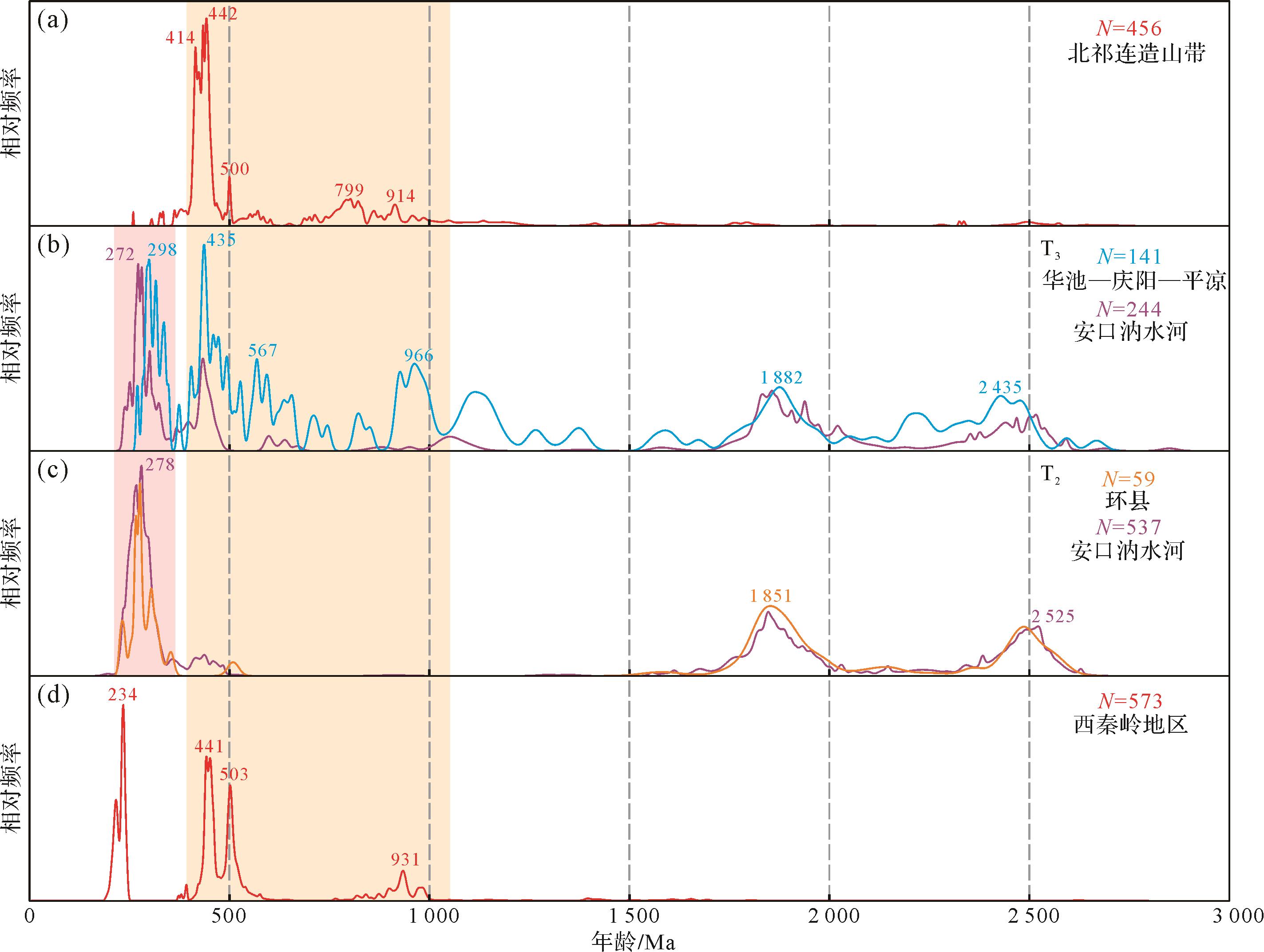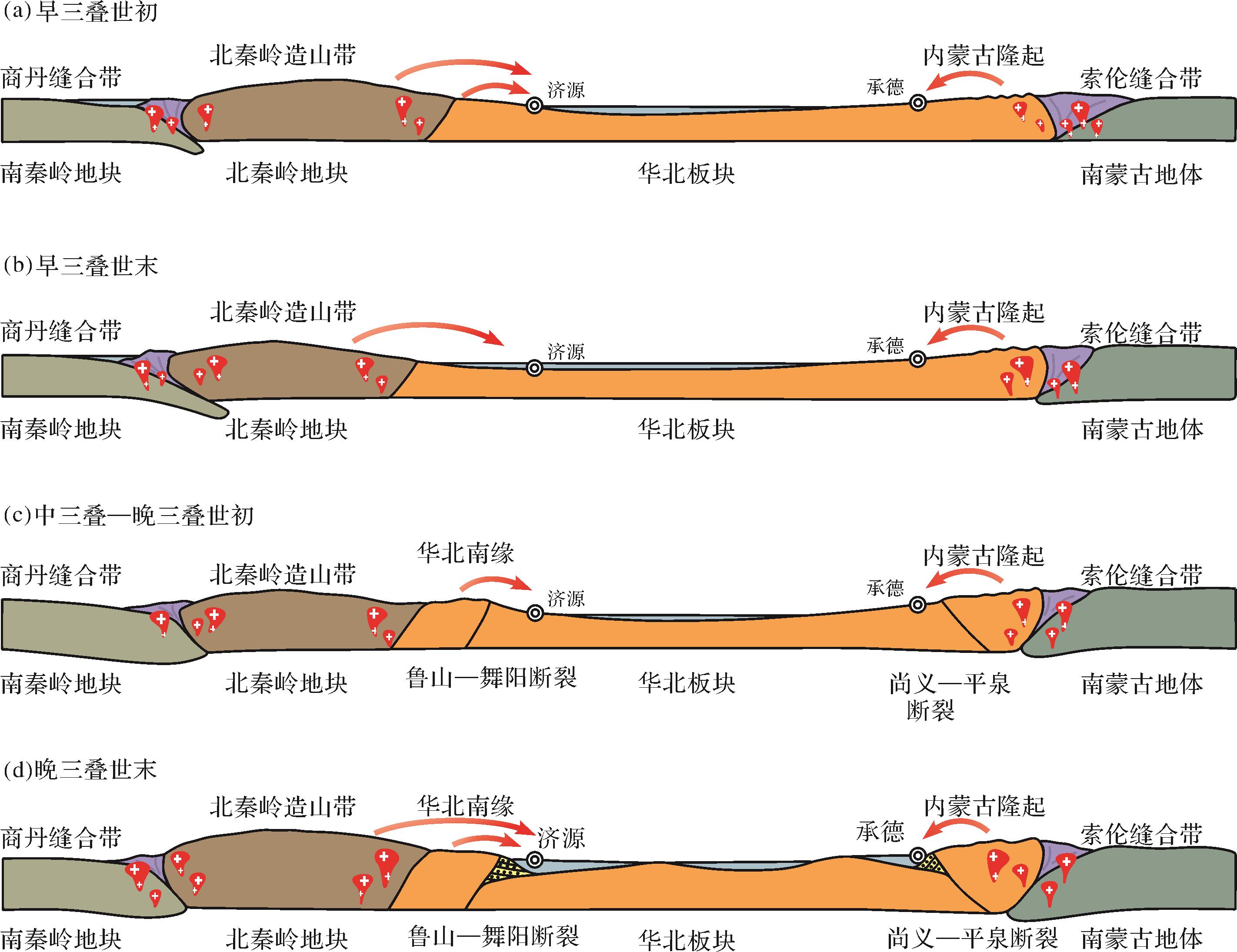HTML
-
自古生代以来,中国大地构造演化受古亚洲洋、特提斯洋和太平洋三大构造域控制[1],而华北板块在三叠纪受西伯利亚板块和扬子板块南北向汇聚碰撞及印度洋板块和古太平洋板块东西向不断挤压的联合作用,形成北接中亚造山带,南邻祁连—秦岭—大别造山带,边缘被古隆起所包围的大型内陆沉积盆地[2-6]。华北盆地内部三叠纪沉积特征作为周缘造山带和隆起区构造演化过程的沉积响应,砂岩中的碎屑锆石U-Pb年龄记录了源区构造活动信息,锆石年龄特征的时空对比为分析源区变化和盆缘地区盆—山构造演化过程提供了可靠依据。近年来,前人关于华北盆地各地区三叠纪碎屑物源的研究已做了大量工作,其中华北北部主要集中在平泉、下板城、北京西山、宁武和太原西山地区早—中三叠世沉积地层,接受的物源主要来自华北北缘内蒙古隆起[2,7-10];华北南部三叠纪碎屑物源研究主要集中在豫西和鄂尔多斯盆地东南部地区,其物源区包括秦岭造山带、内蒙古隆起或华北南缘再旋回沉积盖层[11-18];华北西部大量碎屑锆石物源分析工作主要集中在中—上三叠统,其物源主要由阿拉善地块、北祁连造山带、西秦岭地区岩浆岩和变质岩或鄂尔多斯盆地西缘再旋回沉积盖层提供[6,11,19-26]。学者对盆缘构造活动和沉积演化过程也开展了一定的研究,如沉积体系和物源变化所反映的充填序列记录了内蒙古隆起在晚石炭—中三叠世发生的三次重要隆升和剥蚀过程[7-8];济源地区三叠系自下而上来自秦岭造山带的碎屑锆石年龄呈逐渐变老的趋势,指示了秦岭造山带印支期经历的隆升剥蚀和去顶过程,其沉积充填特征记录了华北南部由内陆沉积盆地向前陆盆地转变的演化过程[27-28];贺兰山地区三叠系碎屑锆石年龄和沉积变化特征与古亚洲洋闭合后阿拉善地块在碰撞后阶段的隆升和伸展构造活动密切相关[6,25]。
然而,目前学者们对华北不同地区三叠纪物源区的认识仍存在分歧,如对于华北南部三叠纪碎屑物源有来自华北北缘内蒙古隆起[12,14]和华北南缘再旋回沉积盖层[13,18]两种观点、对于贺兰山地区与鄂尔多斯盆地西北部磁窑堡和石沟驿地区是否具有同一物源区和沉积体系以及物源区位置也存在不同认识[6,23,29]、对于鄂尔多斯盆地西南部延长组碎屑物源供给方向及物源区的认识仍不明确等[11,19-20,22]。同时,目前对于华北盆地三叠纪物源区的不同认识反映对盆缘地区盆—山系统演化过程的研究仍相对较少,对于碎屑物源特征所指示的华北盆地三叠纪沉积—构造演化过程仍缺乏系统的整体研究。
因此,我们收集了大量前人对华北盆地三叠纪碎屑物源研究的锆石年代学数据、古地理和古流向等基础沉积学资料,结合造山带演化过程、地层沉积特征及锆石U-Pb年龄对华北不同地区三叠纪碎屑物源进行整体研究,建立更大范围的锆石年龄对比有助于明确物源区位置,并进一步分析华北盆地三叠纪沉积物源体系的时空演变特征及其沉积—构造演化过程。
-
华北盆地三叠纪物源特征及盆地沉积—构造演化与其所处的区域地质构造背景密切相关。新元古代—早中生代,华北板块南北两侧受特提斯洋和古亚洲洋构造域控制,其中在古生代加里东—海西期洋壳俯冲与板块汇聚背景下,多岛弧岩体及微地体发生碰撞拼贴并增生至华北板块南北缘,如祁连—柴达木地块及秦岭微地体俯冲增生至华北板块南缘[30-32],白乃庙岛弧、阿拉善地块及蒙古弧地体等碰撞拼贴至华北北缘[33-36];在晚古生代末—早中生代海西—印支期活动造山背景下,华北板块分别与扬子板块和西伯利亚板块碰撞合并,北祁连造山带与秦岭—大别—苏鲁造山带构成华北板块的南部边界,而阿拉善地块、内蒙古隆起和兴蒙造山带则构成华北板块的北部边界(图1)。

Figure 1. Simplified tectonic map of the North China Block and its adjacent regions (modified from reference [37])
北祁连造山带是一条典型的洋壳缝合带,造山带内发育大量新元古代—早古生代高压变质岩(710~421 Ma)、蛇绿岩(550~448 Ma)、岛弧火山岩(517~466 Ma)、花岗侵入岩体(520~460 Ma,440~420 Ma)和少量晚古生代(<400 Ma)花岗岩,记录了祁连洋俯冲闭合,祁连—柴达木地块与阿拉善地块碰撞合并及造山后伸展过程[30]。
秦岭—大别—苏鲁造山带位于华北板块与扬子板块之间,是一条复合造山带,在显生宙经历了多阶段的构造演化过程,包括早古生代大洋岛弧增生,原特提斯洋洋壳俯冲和弧—陆碰撞,志留纪裂陷伸展构造体制下古特提斯洋打开,晚二叠世—三叠纪俯冲阶段发生高压—超高压变质作用及随后的大陆碰撞造山并发生剥蚀作用[31-32,38-41]。其中,秦岭造山带是由断裂和缝合带分割的多个地体单元组成,在多期次的俯冲和碰撞造山过程中伴随着强烈的岩浆活动和变质作用,其中位于商丹缝合带以北的北秦岭造山带以早古生代(510~400 Ma)、新元古代(979~726 Ma)和早中生代(218~206 Ma)花岗岩体为主[40,42-43],商丹缝合带和勉略缝合带之间的南秦岭地区具有与扬子板块相似的克拉通基底和盖层年龄特征,花岗侵入岩体的年龄集中在新元古代(759~686 Ma)和早中生代(252~185 Ma)[14,43-44];大别—苏鲁造山带形成于三叠纪扬子板块与华北板块俯冲碰撞造山,花岗岩体的侵入年龄集中在770 Ma、212 Ma和126 Ma[45-48]。
阿拉善地块作为古老克拉通的一部分以恩格尔—乌苏缝合带、查干楚鲁缝合带和巴彦乌拉断裂为界,自北向南可分为宗乃山构造带、诺尔公—狼山构造带和巴彦浩特盆地[6,25],其中北部构造带除出露新太古代—古元古代基底岩石外,宗乃山构造带以中元古代(1.5~1.4 Ga)火山岩大量出现为特征[49],诺尔公—狼山构造带广泛发育新元古代(930~910 Ma)的S型花岗岩及早古生代—早中生代(460~200 Ma)与中亚造山带南缘古亚洲洋向南俯冲碰撞相关的岩浆侵入岩体[50-53]。
内蒙古隆起位于华北板块北缘,平泉—古北口—赤城—尚义断裂以北[54],华北北缘在中元古代哥伦比亚超大陆裂解之后,进入被动大陆边缘演化阶段,并在晚志留世与白乃庙岛弧发生弧—陆碰撞[33,55]。晚石炭—晚二叠世,古亚洲洋向华北板块之下俯冲,华北北缘发展为安第斯型活动大陆边缘,并伴随着强烈的岩浆活动,发生多次构造隆升,花岗岩体的侵入年龄在420~360 Ma、330~280 Ma和270~240 Ma[8,34]。
兴蒙造山带位于华北板块以北,中亚造山带东段,目前关于兴蒙造山带构造演化历史及古亚洲洋的闭合时间和方式问题仍存在争议。传统观点认为中亚造山带从早古生代就开始俯冲增生,发生多次地体拼贴并存在多条俯冲带,古亚洲洋在晚二叠—中三叠世沿索伦—西拉木伦缝合带最终闭合[56-59];新观点认为古亚洲洋在早古生代经历南北双向俯冲之后,在晚泥盆世闭合形成兴蒙造山带,在后期伸展构造背景下发育陆内裂谷或小洋盆,并在早三叠世再次闭合形成兴蒙陆内造山带[3,60-61]。古亚洲洋俯冲增生及地体碰撞造山过程中伴随强烈的岩浆侵入、喷出活动及区域变质作用,断裂带和缝合带附近报道的地质年代学数据显示,古生代花岗岩体的年龄主要集中在530~460 Ma、340~290 Ma和280~240 Ma[2,58,62]。
-
早三叠世,华北板块延续了晚二叠世以来的沉积—构造格局,为大型内陆坳陷盆地演化阶段,以干热气候条件下的紫红色河湖相碎屑沉积为主,沉积中心位于济南和延安地区附近,下三叠统在华北内部普遍接受沉积,发育刘家沟组和和尚沟组(图2、图3a,b)。华北北部刘家沟组主要为灰白—紫红色钙质砂岩沉积,发育低角度交错层理和平行层理,形成于辫状河环境;和尚沟组发育一套紫红色泥岩与灰白—紫红色钙质砂岩或砾岩互层的岩石组合,为曲流河沉积[7]。宁武地区刘家沟组交错层理恢复的古流方向为南和东南方向[10]。华北南部刘家沟组以厚层或巨厚层的紫红色细砂岩沉积为主,夹薄层浅紫红色泥岩和泥质粉砂岩,为炎热干旱气候条件下的河流相沉积;和尚沟组主要发育紫红色泥岩、粉砂质泥岩和粉砂岩,泥岩中常见钙质结核,为干燥气候条件下的滨—浅湖沉积[28]。豫西地区刘家沟组恢复的古水流方向指向北西方向[65]。鄂尔多斯盆地西缘部分地区同样发育早三叠世沉积地层,其中刘家沟组主要由灰白—紫红色含砾砂岩、粉砂岩和粉砂质泥岩组成;和尚沟组发育一套紫红色泥岩和泥质粉砂岩夹灰绿色薄层砂岩或含泥砾砂岩,地层厚度相对稳定[29]。华北东部临清坳陷刘家沟组以紫红色粉砂岩、粉砂质泥岩与泥岩互层为特征,和尚沟组岩性主要为紫色、棕色粉砂岩、钙质砂岩等夹紫红色泥岩[66]。

Figure 2. Regional distribution of strata and sequence correlation of the North China Block in the Late Paleozoic⁃Early Mesozoic

Figure 3. Tectonic⁃paleogeography and provenance division in the North China Basin from the Late Paleozoic to the Early Mesozoic (modified from references [37,63⁃64])
中三叠世,华北盆地逐步向中西部收缩,气候条件由炎热干旱逐渐转为温暖湿润,沉积中心位于延安地区附近,盆地内发育连续的冲积扇—河流三角洲—湖泊相沉积(图3c)。其中,华北北部燕山地区中三叠统仅存二马营组于下板城—平泉一带,与下三叠统一致,为一套河流相红色碎屑岩建造[67];宁武地区二马营组和铜川组以灰绿色、黄绿色长石砂岩与粉砂岩或砂质泥岩互层为特征,古流指向南至东南方向[10]。华北南部中三叠统自下而上包括二马营组和油房庄组,岩性同样以灰黄色细砂岩与紫红色泥岩、粉砂质泥岩互层为特征,该地层在豫西地区沉积厚度大,分布稳定,受后期华北板块东部抬升剥蚀影响,向东地层厚度逐渐减薄,并与上三叠统或下侏罗统不整合接触[28,68](图2)。华北西部鄂尔多斯盆地西缘中三叠统纸坊组为一套灰紫色、黄绿色细砂岩与深紫色、灰绿色粉砂质泥岩组合[29];盆地西北部贺兰山地区纸坊组发育自下而上由灰绿色厚层含砾砂岩夹薄层红色砂质泥岩向含砾砂岩和卵砾石沉积交替出现的粒度变粗的沉积序列,对应的沉积环境由辫状河沉积向冲积扇辫状河道沉积转变,表现为进积的沉积特征[6]。
晚三叠世,华北北部和东部地区发生抬升剥蚀,仅在承德和辽西等地区沿褶皱冲断带发育以冲洪积扇沉积为主的小型盆地[68],华北盆地内部沉积范围和沉积中心进一步向西南部退缩,整体为湿润气候条件下的三角洲—湖泊相沉积(图3d)。该时期,华北北部承德盆地上三叠统杏石口组不整合于二马营组之上,其下部以灰白色块状复成分砾岩为主,上部发育黄绿色厚层含砾砂岩夹薄层粉砂质泥岩[69];宁武地区上三叠统延长组以灰绿色、黄绿色中—细粒长石砂岩与粉砂岩或砂质泥岩互层为特征,向上与下侏罗统永定庄组不整合接触,恢复的古流向指向南东方向[10]。华北南部上三叠统在豫西地区和鄂尔多斯盆地东南部沉积厚度大,岩性、岩相分布稳定,其中济源地区上三叠统发育椿树腰组和谭庄组,椿树腰组以灰黄色、黄绿色厚层细砂岩、粉砂岩与泥岩互层为特征,为湿润气候条件下的滨浅湖沉积;谭庄组以米黄色、黄绿色泥岩与粉砂岩互层为特征,夹灰色碳质泥岩和煤线,向上发育油页岩,为滨浅湖—深湖沉积[28]。华北西部延长组上下分别与下侏罗统富县组和中三叠统纸坊组不整合接触,其中鄂尔多斯盆地西南缘延长组以灰绿色砂岩与暗紫红色砂质泥岩、灰黑色泥岩和粉砂岩互层为主[70],西北部贺兰山地区延长组下部为砾岩、厚层含砾砂岩和粗砂岩沉积,中部主要为砂岩夹黑色泥岩,发育软沉积变形构造,延长组上部细砂岩、黑色泥岩与厚层页岩交替出现。整体自下而上表现为由辫状河至三角洲沉积,再至浅湖—深湖沉积[6]。华北东部在中—晚三叠世印支期不断抬升,上三叠统整体缺失(图2)。
-
依据周缘地区不同源区特征锆石年龄,可将华北内部不同地区三叠纪沉积地层中的碎屑锆石年龄分为新太古代—古元古代(>1 600 Ma)、中元古代—早古生代(1 600~390 Ma)和晚古生代(<390 Ma)三个年龄段。结合三叠纪华北不同地区锆石年龄段分布、古地理和古流向特征,可将华北盆地划分为北部、南部和西部三个沉积物源区,编号分别为Ⅰ、Ⅱ和Ⅲ(图3)。
-
在区域Ⅰ,我们收集了华北盆地北部下板城、平泉、北京西山、宁武、太原西山和延安地区三叠纪不同组对应的碎屑锆石年龄数据(表1),并绘制了如图4所示的锆石年龄频谱图。其中,所有选择的锆石U-Pb年龄不谐和度均小于10%,年轻锆石(<1 000 Ma)单点误差1σ多在10 Ma以内,最大单点误差为39 Ma,晚古生代锆石颗粒多呈自形—半自形,具有明显的岩浆振荡生长环带[8,10,12],锆石Th/U比值为0.01~43.74,以岩浆锆石 (Th/U>0.4)为主(81.16%,784/966),变质锆石(Th/U<0.1)较少(0.93%,9/966)。早三叠世,下板城和平泉地区具有相似的锆石年龄频谱特征,形成382 Ma、324 Ma、256 Ma三个晚古生代锆石年龄峰值以及2 528 Ma和1 856 Ma两个新太古代—古元古代年龄峰值[8-9];宁武和太原西山也具有相似的年龄频谱特征,形成405 Ma、302 Ma和272 Ma三个晚古生代年龄峰值以及2 516 Ma和1 874 Ma两个新太古代—古元古代年龄峰值[10,71];延安地区以晚古生代锆石年龄(255 Ma、309 Ma和340 Ma)为主,新太古代—古元古代碎屑锆石较少[74]。中三叠世,下板城、宁武和延安地区碎屑锆石年龄主要集中在晚古生代(253 Ma、287 Ma和386 Ma)和新太古代—古元古代(2 470 Ma、1 868 Ma)两个年龄段[9-10,74]。晚三叠世,北京西山杏石口组以峰值为295 Ma和205 Ma的晚古生代—早中生代锆石年龄为主[2];宁武地区晚古生代碎屑锆石具有260 Ma的主峰值年龄及247 Ma、273 Ma、298 Ma和316 Ma多个次峰值年龄,新太古代—古元古代碎屑锆石形成1 840 Ma和2 499 Ma两个主年龄峰值[12]。
区域 采样位置与层位 岩性与样品编号 碎屑锆石年龄组成(%)/Ma 锆石数量/个 数据来源 华北北部 下板城二马营组 砂岩Sandie 5, 7 388~221 (41%) 2 552~1 632 (59%) N=179 Meng et al.[9] 下板城刘家沟组 砂岩Sandie 1-3 400~240 (40%) 463 2 589~1 665 (60%) N=274 平泉刘家沟组 砂岩LJG 405~247 (25%) 2 618~1 748 (75%) N=96 Ma et al.[8] 北京西山杏石口组 砂岩FW04-121 329~203 (59%) 2 559~1 706 (41%) N=58 Yang et al.[2] 宁武上三叠统下部 细砂岩N-4 317~238 (24%) 2 520~1 547 (76%) N=74 Li et al.[12] 宁武二马营组 砂岩T2er-2 307~240 (26%) 2 558~1 739 (74%) N=94 Zhou et al.[10] 宁武刘家沟组 砂岩T1l-1 409~258 (26%) 2 621~1 661 (74%) N=93 太原西山刘家沟组 砂岩LJG 418~255 (29%) 3 126~1 563 (70%) N=133 刘超等[71] 华北南部 济源谭庄组 细砂岩T-t 383~248 (13%) 1 539~738 (15%) 2 890~1 658 (72%) N=79 Yang et al.[13] 济源椿树腰组 细砂岩T-c 388~241 (19%) 2 683~1 740 (81%) N=75 济源油房庄组 中砂岩T-y 351~245 (25%) 2 655~1 703 (75%) N=72 济源二马营组 细砂岩S-3 367~236 (47%) 2 651~1 635 (53%) N=74 彭深远等[72] 济源和尚沟组 细砂岩S-2 1 381~382 (84%) 2 687~1 573 (16%) N=76 济源刘家沟组 细砂岩S-1 387~250 (22%) 821~427 (12%) 3 217~1 794 (66%) N=75 济源上三叠统上部 细砂岩J-9 372~228 (38%) 469 2 562~ 1626 (61%) N=66 Li et al.[12] 济源上三叠统中部 细砂岩J-7 363~243 (37%) 2 636~1 696 (63%) N=67 登封油房庄组 砂岩DF6-1 367~221 (43%) 514 2 596~1 670 (56%) N=83 Yang et al.[14] 三门峡油房庄组 砂岩SMX1-1 327~235 (35%) 446~438 (4%) 2 582~1 629 (61%) N=53 三门峡二马营组 砂岩SMX2-1 388~232 (49%) 2 679~1 600 (51%) N=88 宜阳和尚沟组 中砂岩Y-H 1 048~436 (82%) 2 453~1 791 (18%) N=103 Wang et al.[18] 宜阳刘家沟组 粗砂岩 Y-L 403~259 (17%) 1 229~424 (25%) 2 748~1 583 (58%) N=102 宜川延长组下部 中砂岩ZXW-20 275~248 (10%) 2 582~1 608 (90%) N=54 Zhang et al.[17] 宜川纸坊组 中砂岩YC-1 356~263 (21%) 2 563~1 693 (79%) N=53 韩城纸坊组 中砂岩HC-2 350~247 (17%) 2 636~1 673 (83%) N=58 黄龙延长组长5-4 粉砂岩DN34 340~213 (45%) 1 450~1 160 (2%) 2 488~1 541 (52%) N=86 王娟[15] 黄陵延长组长5-4 细砂岩DN29 354~236 (15%) 475 2 685~1 543 (84%) N=93 黄龙延长组长6 细砂岩DN37 294~226 (29%) 430 2 635~1 617 (70%) N=89 铜川延长组长6 砂岩DN11 342~255 (7%) 1 393~400 (28%) 2 599~1 644 (65%) N=97 铜川延长组长7 砂岩DN19 314~235 (9%) 1 451~411 (19%) 3 248~1 677 (72%) N=82 黄龙延长组长6 细砂岩DN37 294~226 (31%) 2 635~1 617 (66%) N=97 乔向阳等[73] 铜川延长组长6 砂岩DN11 342~255 (7%) 1 168~400 (22%) 2 730~1 644 (55%) N=99 铜川延长组长8 细砂岩TC8 369~261 (13%) 468~448 (4%) 2 652~1 793 (82%) N=68 Xie et al.[11] 铜川延长组长9 中砂岩DN-02 358~229 (46%) 2 586~1 747 (54%) N=63 吴桐桐[16] 宜川延长组长8 中砂岩DN-40 371~233 (38%) 2 639~1 731 (62%) N=89 宜川延长组长10 细砂岩DN-42 366~239 (29%) 2 677~1 726 (71%) N=99 宜君延长组长10 中砂岩DN-23 349~231 (24%) 2 608~1 696 (76%) N=112 华北西部 贺兰山上三叠统 砂岩WH-11-2 357~249 (14%) 1 377~1 344 (14%) 2 776~1 803 (71%) N=14 Shi et al.[26] 贺兰山中三叠统 砂岩WH-4, 7, 25 382~266 (23%) 670~447 (4%) 2 815~1 803 (72%) N=47 区域 采样位置与层位 岩性与样品编号 碎屑锆石年龄组成(%)/Ma 锆石点数/个 数据来源 华北西部 贺兰山延长组上部 细砂岩HL-21 422~208 (25%) 1 053~504 (8%) 2 551~1 558 (67%) N=64 Sun et al.[6] 贺兰山延长组中部 中砂岩HL-18 335~205 (16%) 917~381 (33%) 2 755~1 588 (49%) N=61 贺兰山延长组下部 粗砂岩HL-17 327~293 (5%) 1 256~959 (4%) 2 682~1 729 (91%) N=61 汝箕沟口纸坊组 粗砂岩HL-16 310~256 (12%) 457~410 (5%) 2 560~1 731 (82%) N=61 汝箕沟延长组长3-2 砂岩16RJG01 371~252 (20%) 951~490 (6%) 2 654~1 807 (72%) N=64 李亚男[23] 磁窑堡延长组长7-4 砂岩17CYB05 435~268 (34%) 742 2 765~1 829 (63%) N=76 磁窑堡延长组长9-8 砂岩17CYB04 410~287 (6%) 2 564~1 732 (94%) N=83 炭井沟延长组长9-8 砂岩16TJG01 360~272 (18%) 458~420 (2%) 2 610~1 599 (80%) N=79 插旗口延长组长9-8 砂岩15CQK08 396~271 (10%) 479~441 (4%) 2 591~1 776 (86%) N=79 石沟驿上三叠统 砂岩SGY-001 311~259 (11%) 514~442 (6%) 2 600~1 753 (83%) N=53 张义楷[29] 窑山延长组上部 粗砂岩YS1-3 450~220 2 700~16 50 — 谭聪等[24] 麻黄沟延长组上部 中砂岩MH1 450~230 2 550~1 750 — 华池延长组长6 砂岩li78 348~269 (22%) 1 097~405 (38%) 2 451~1 857 (38%) N=37 孙迪等[21] 玄马延长组长6 砂岩zhuang33 373~294 (14%) 1 177~400 (49%) 2 668~1 788 (33%) N=43 平凉延长组长6 砂岩yan40 318~291 (6%) 1 367~446 (47%) 2 594~1 559 (43%) N=49 汭水河延长组长6 砂岩rsh04 323~248 1 572~430 2 589~1 745 N=51 环县延长组下部 中砂岩ZXW-22 353~228 (29%) 1 581~509 (3%) 2 580~1 767 (68%) N=57 Zhang et al.[17] 环县延长组长10 砂岩环78 361~248 2 711~1 634 — 李元昊等[22] 盐池延长组长10 砂岩安99 373~234 2 537~1 647 — 华池延长组长10 砂岩白212 526~251 (16%) 2 597~1 564 (84%) — 庆阳延长组长10 砂岩宁65 370~224 (25%) 2 644~1 637 (75%) — 汭水河延长组长8 中砂岩AK8 307~252 (10%) 473~411 (3%) 2 591~1 673 (87%) N=90 Xie et al.[11] 汭水河延长组长6 砂岩RUIHE17 366~235 (18%) 1 106~1 022 (16%) 2 591~1 812 (65%) N=57 宋立军等[19] 汭水河延长组长9 中砂岩RUIHE9 303~256 (23%) 2 628~1 556 (77%) N=70 汭水河延长组上部 细砂岩RSH3 412~239 (41%) 1 380~420 (27%) 2 493~1 754 (32%) N=123 Xie[20] 汭水河延长组中部 中砂岩RSH2 412~225 (58%) 1 351~422 (7%) 2 600~1 600 (35%) N=191 汭水河延长组下部 中砂岩RSH1 421~227 (46%) 911~467 (3%) 2 623~1 648 (51%) N=186 延安上三叠统下部 细砂岩Y-4 343~288 (11%) 2 522~1 675 (89%) N=66 Li et al.[12] 延安上三叠统上部 砂岩YA06-1 408~246 (6%) 1 483~441 (71%) 2 794~1 613 (23%) N=73 Bao et al.[74] 延安上三叠统下部 砂岩YA09-1 309~245 (17%) 434 (2%) 2 566~1 647 (81%) N=64 延安中三叠统 砂岩YA13-1 386~232 (24%) 1 083~486 (3%) 2 736~1 772 (73%) N=63 延安下三叠统 砂岩YA11-1 341~245 (31%) 467 2 879~1 731 (66%) N=35
-
在区域Ⅱ,我们收集了南部韩城、宜川、黄龙、黄陵、铜川、济源、三门峡、登封和宜阳地区三叠纪碎屑锆石年龄数据(表1),结果如图5所示。其中,所有选择的锆石U-Pb年龄不谐和度均小于10%,年轻锆石(<1 000 Ma)单点误差1σ多在10 Ma以内,最大单点误差为41 Ma,锆石颗粒多呈半自形的振荡或扇状环带结构[14,18,87],指示其多为岩浆作用成因,锆石Th/U比值为0.02~3.86,以岩浆锆石(Th/U>0.4)为主(78.08%,919/1 177),变质锆石(Th/U<0.1)较少(1.87%,22/1 177)。早三叠世,济源和宜阳地区具有相似的锆石年龄特征,以早古生代(420 Ma、445 Ma)和新太古代—古元古代(1 885 Ma、2 511 Ma)碎屑锆石为主,晚古生代(270 Ma)和新元古代(747 Ma、956 Ma)锆石年龄则相对较少[18,72]。中三叠世,华北南部各地区具有一致的锆石年龄分布特征,主要集中在晚古生代(245 Ma、255 Ma、280 Ma和357 Ma)和新太古代—古元古代(2 504 Ma、1 824 Ma)[13-14,17,72],此外,铜川地区出现少量早古生代碎屑锆石(447 Ma)[11,16]。晚三叠世,黄龙—黄陵、铜川和济源地区仍然具有相似的晚古生代(261 Ma)和前寒武纪(1 883 Ma、2 523 Ma)锆石年龄特征,而新元古代—早古生代碎屑锆石也逐渐增多,在铜川地区增加最为明显,形成453 Ma、417 Ma和912 Ma等多个年龄峰值[13,15]。
-
在区域Ⅲ,我们分别收集了鄂尔多斯盆地西北部贺兰山、磁窑堡、定边、石沟驿和延安地区以及西南部华池、庆阳、平凉、环县和安口地区纸坊组和延长组中的碎屑锆石年龄数据(表1),锆石年龄频谱图如图6和图7所示。其中,所有选择的锆石U-Pb年龄不谐和度均小于10%,年轻锆石(<1 000 Ma)单点误差1σ多在15 Ma以内,最大单点误差为43 Ma,锆石颗粒以半自形长柱状和次圆状为主,内部具有岩浆振荡环带、均质弱分带或核—边结构[6,21],锆石Th/U比值为0.01~12.87,以岩浆锆石(Th/U>0.4)为主(77.53%,652/841),变质锆石(Th/U<0.1)较少(2.50%,21/841)。锆石年龄频谱特征显示,西北部贺兰山地区中三叠统纸坊组和延长组下部具有较多的新太古代—古元古代(1 884 Ma、2 478 Ma)和晚古生代(297 Ma)锆石年龄,而上三叠统延长组上部则以较多的早古生代(417 Ma)和新元古代(927 Ma、637 Ma)锆石出现为特征[6,26];磁窑堡地区中—上三叠统具有相似的锆石年龄分布,新太古代—古元古代锆石年龄集中在1 902 Ma和2 455 Ma,古生代碎屑锆石形成308 Ma和461 Ma两个年龄峰值[23];定边地区延长组下部碎屑锆石主要集中在新太古代—古元古代(1 882 Ma、2 478 Ma)和晚古生代—早中生代(292 Ma、245 Ma和359 Ma)两个年龄段[22];石沟驿剖面延长组上部则以新太古代—古元古代(1 911 Ma、2 498 Ma)锆石年龄为主,少量古生代碎屑锆石形成279 Ma、483 Ma和431 Ma三个年龄峰值[23,29];延安地区上三叠统除具有新太古代—古元古代(2 499 Ma、1 853 Ma)及晚古生代(246 Ma)锆石年龄外,较多的新元古代—早古生代碎屑锆石在765 Ma和444 Ma形成峰值[74]。西南部环县和安口汭水河地区中三叠统延长组下部均以晚古生代(278 Ma)及新太古代—古元古代锆石(1 851 Ma、2 525 Ma)年龄为主[11,17,19-20],而华池—庆阳—平凉及安口汭水河地区上三叠统延长组上部新元古代—早古生代(435 Ma、567 Ma和966 Ma)碎屑锆石则明显增多[20-21]。
-
通过华北盆地三叠纪古地理沉积特征、古流向分布及盆地内各沉积区域与周缘造山带或隆起区锆石年龄对比可以发现,华北北部潜在的碎屑物源区为内蒙古隆起和兴蒙造山带,南部地区沉积物源可能来自北秦岭造山带和华北南缘,而西部地区碎屑物源则可能来自阿拉善地块、北祁连造山带和西秦岭地区。
-
将华北北部各地区(区域Ⅰ)三叠纪沉积地层中的碎屑锆石年龄与作为潜在物源区的华北北缘内蒙古隆起及兴蒙造山带古生代花岗侵入岩体的年龄进行对比可以发现,华北北部三叠纪碎屑锆石与兴蒙造山带和内蒙古隆起内的岩浆锆石具有相似的晚古生代年龄峰值,并主要集中在275~250 Ma、340~280 Ma和410~360 Ma三个年龄段(图4)。由于兴蒙造山带内大量晚古生代岩浆岩体中的锆石εHf(t)值多为正,指示其来自于初生地壳,而内蒙古隆起晚古生代岩浆锆石多具有负的εHf(t)值和老的亏损地幔Hf同位素模式年龄,表明其应来自于下地壳部分熔融[2,10,12,44],华北北部地区晚古生代碎屑锆石具有与内蒙古隆起岩浆锆石一致的εHf(t)值(图4),结合锆石年龄频谱特征及εHf(t)值,认为华北北部地区三叠纪沉积地层中的晚古生代碎屑组分应来自内蒙古隆起。2.6~2.4 Ga和2.1~1.7 Ga的新太古代—古元古代碎屑锆石在古生代沉积盖层中广泛分布[7],这些年龄的锆石在华北前寒武纪基底也广泛分布[122-123]。由于内蒙古隆起自晚古生代隆升以来,古生代沉积地层已被剥离且基底变质杂岩广泛出露[4,8,124],而兴蒙造山带具有较少的新太古代—古元古代锆石[77],因此华北北部较多的前寒武纪碎屑锆石应来自华北北缘的内蒙古隆起。
-
通过华北南部各地区(区域Ⅱ)三叠纪沉积地层中的碎屑锆石年龄与华北南部沉积盖层以及北秦岭造山带花岗岩体中的锆石年龄进行对比,可以发现华北南部三叠系中晚古生代和新太古代—古元古代碎屑锆石年龄与下伏中—上二叠统及华北南缘基底岩体中的锆石年龄有较好的对应(图5d),而新元古代—早古生代锆石年龄与北秦岭造山带内多期次的花岗侵入岩体中的岩浆锆石年龄一致(图5e)。值得注意的是,华北南部下三叠统刘家沟组—和尚沟组晚古生代碎屑锆石逐渐减少,而新元古代—早古生代锆石年龄则逐渐增多[18,72]。一些学者认为豫西地区石千峰组顶部出现的晚古生代碎屑锆石来自华北北缘的内蒙古隆起[14,44],然而早三叠世自南向北的古流向并不能支持这一观点[65]。考虑到华北南部在二叠纪北高南低的古地势下接受了大量来自华北北缘内蒙古隆起的碎屑物源[14,28,87,125],且靠近华北南缘的登封和宜阳地区二叠系缺乏边缘相[14,87],华北南缘在该时期也应沉积了二叠纪地层并具有与之相似的锆石年龄特征(图3a),而如今则以老的前寒武纪基底为主。因此,华北南部下三叠统中晚古生代和新太古代—古元古代碎屑锆石可能来自华北南缘首先被剥蚀的二叠纪再旋回沉积盖层,其初始物源为华北北缘的内蒙古隆起,而新元古代—早古生代碎屑锆石则直接来自北秦岭造山带。华北南部地区在早三叠世应同时接受了来自华北南缘和北秦岭造山带的碎屑物源。中三叠世,除铜川地区具有少量早古生代锆石年龄外,华北南部其他地区均以晚古生代和新太古代—古元古代碎屑锆石为主,而在勉略洋俯冲闭合背景下,在早三叠世已处于挤压隆升状态下的北秦岭造山带不太可能在中三叠世停止隆升或开始沉降[31-32],因此,可能的解释为华北南缘在该时期发生逆冲隆起,在阻挡了来自秦岭造山带物质输入的同时也为华北南部地区提供了大量碎屑沉积物。晚三叠世,华北南部各地区较多的晚古生代及新太古代—古元古代碎屑锆石同样应来自华北南缘二叠纪沉积盖层,而再次出现的新元古代—早古生代锆石年龄则对应来自北秦岭造山带,说明了晚三叠世印支期华北板块与扬子板块之间的碰撞挤压使得秦岭造山带快速隆升,并逐渐越过华北南缘为华北南部地区提供物源。
-
将鄂尔多斯盆地西北部不同地区中—上三叠统碎屑锆石年龄与阿拉善地块和北祁连造山带岩浆或变质岩体中的锆石年龄进行对比可以发现:1)中三叠统纸坊组和延长组下部碎屑锆石年龄主要集中在新太古代—古元古代以及晚古生代,与阿拉善地块具有相似的年龄频谱特征(图6a);2)上三叠统延长组上部逐渐增多的新元古代—早古生代碎屑锆石在阿拉善地块和北祁连造山带均有出现(图6e)。阿拉善地块东部发育前寒武纪基底杂岩,如巴彦乌拉山杂岩,而北部地区在奥陶—三叠纪受中亚造山带持续向南的俯冲碰撞影响逐渐隆升并发育大量古生代花岗岩体[6,126-127],因此,阿拉善地块可以在中—晚三叠世为鄂尔多斯盆地西北部提供大量新太古代—古元古代及晚古生代碎屑物源。贺兰山、磁窑堡和石沟驿地区三叠纪古水流方向主要为东和东南方向,而延长组古水流方向较纸坊组出现更多的指向东北方向的水流数据[6,26],说明来自西南方向的物源逐渐增多,结合锆石年龄数据,认为北祁连造山带可以为盆地西北部地区延长组上部提供早古生代及新元古代碎屑组分。因此,鄂尔多斯盆地西北部中三叠世碎屑物源主要来自阿拉善地块,晚三叠世物源可能同时来自阿拉善地块和北祁连造山带。
将鄂尔多斯盆地西南部中—上三叠统碎屑锆石年龄与北祁连造山带和西秦岭地区锆石年龄对比可以发现:1)中—上三叠统延长组下部和上部均出现较多的晚古生代和新太古代—古元古代碎屑锆石,但北祁连造山带和西秦岭地区缺乏这两部分锆石年龄;2)上三叠统延长组上部较下部出现更多的早古生代和新元古代锆石年龄,与北祁连造山带和西秦岭地区具有相似的年龄特征。目前对于西南部地区延长组中的晚古生代碎屑锆石物源仍有多种认识,如可能来自华北北缘、阿拉善地块华力西期岩浆岩、北秦岭造山带内古生代再旋回沉积岩等[17,20-21]。然而,根据华北地区中—晚三叠世地层沉积厚度,华北盆地沉积中心应位于铜川和济源地区附近[128],且西南部地区地层厚度向东北方向盆地内部逐渐增加,其碎屑物源应来自盆地西南缘,而非华北北缘或阿拉善地块;其次,环县、华池等地与安口汭水河中—上三叠统具有相似的晚古生代和新太古代—古元古代锆石年龄特征,其碎屑物源在盆地西南部各地区应具有同一源区。考虑到鄂尔多斯盆地西南缘奥陶纪灰岩之上发育一套晚古生代(晚石炭世—二叠纪)海—陆过渡相碎屑岩系[129-131],其下—中二叠统中存在大量来自北部阴山地区或南部秦岭造山带的晚古生代及新太古代—古元古代碎屑锆石[131-133](图3a)。因此,中—晚三叠世受勉略有限洋盆闭合影响,祁连造山带东段挤压作用加剧,发生抬升剥蚀的盆地西南缘二叠纪沉积盖层可以为西南部地区提供晚古生代和新太古代—古元古代碎屑组分。由于庆阳—平凉地区较南部安口汭水河在上三叠统同一层位出现更多的新元古代—早古生代锆石年龄(图7b),其物源更多的应来自盆地西缘的北祁连造山带而非西秦岭地区,这也得到指向东南方向的古流向数据的支持[20](图3d)。因此,鄂尔多斯盆地西南部中—晚三叠世碎屑物源应主要来自西南缘二叠纪沉积盖层和北祁连造山带。
-
通过对华北各地区三叠纪碎屑锆石年龄的时空对比和分析不仅可以反映源区及其构造演化信息,结合华北盆地三叠纪地层沉积特征能够很好地指示盆—山相互作用及盆地沉积—构造演化过程。
碎屑锆石年龄特征及源区分析结果显示,华北北部地区三叠纪碎屑物源主要来自内蒙古隆起。其中,集中在三个年龄段的晚古生代碎屑锆石与内蒙古隆起晚古生代岩浆锆石具有相似的峰值年龄和一致的锆石εHf(t)值,对应晚古生代华北北缘在古亚洲洋俯冲闭合,块体碰撞背景下发生的多次岩浆活动及多阶段的隆升和剥蚀作用[8,34],而逐渐变新的晚古生代锆石主年龄峰值也指示了源区逐渐增强的构造活动和持续的岩浆作用。缺少来自兴蒙造山带的初生地壳特征锆石年龄说明内蒙古隆起在三叠纪应具有更高的古地势,在为华北盆地内部提供大量碎屑沉积物的同时阻挡了其北部兴蒙造山带的物质输入。华北北缘内蒙古隆起自晚古生代以来经历了多期次的岩浆活动和构造隆升,也使得华北北部不断抬升,表现为由晚石炭—早二叠世的扇三角洲沉积转为中—晚二叠世的曲流河沉积,早—中三叠世则接受广泛的辫状河沉积[4]。中—晚三叠世,华北北部部分地区出现沉积间断,与上覆上三叠统杏石口组不整合接触[68,134]。晚三叠世,尚义—平泉断裂以北发育向南的逆冲推覆构造,以南则沿褶皱冲断带发育众多呈东西向线性分布的小型盆地,沉积的杏石口组下部为冲积扇相厚层磨拉石砾岩或砂砾岩组合,上部以深水河湖相泥页岩夹细砂岩为特征[69,135-136]。因此,三叠纪古地理及地层沉积特征指示华北北部在早—中三叠世发育北高南低的辫状河—曲流河沉积体系,沉积相带连续分布,向南逐渐过渡为三角洲—湖泊相沉积,整体为华北大型内陆沉积盆地的一部分;晚三叠世陆—陆碰撞使得华北北缘南北向挤压作用加剧,华北盆地北部基底整体继续抬升,由原来的沉积区向过渡区甚至剥蚀区转变,而向南的逆冲推覆构造不断加载使得盆缘地区基底挠曲沉降,在华北北缘形成沿逆冲断裂带分布的陆内前陆盆地系统,向南则逐渐过渡到内陆沉积盆地[68](图8)。

Figure 8. Tectonic evolution pattern of the north and south margins of the North China Block in the Triassic
华北南部三叠纪碎屑物源主要来自华北南缘再旋回沉积物,仅在早三叠世和晚三叠世末期出现来自北秦岭造山带的碎屑组分。其中,下三叠统中来自北秦岭造山带的新元古代—早古生代碎屑锆石逐渐增多可能指示该时期持续增强的造山过程,然而地层沉积特征显示,刘家沟组沉积时期华北南部济源—宜阳地区发育河流—三角洲沉积体系,至和尚沟组沉积期砂岩含量明显减少,并以滨—浅湖相泥质或粉砂质沉积为主[18,28,87],湖盆扩张,水体变浅以及碎屑物质供应减少的沉积特征并不支持上述观点。因此,这可能是秦岭造山带向北挤压作用减弱,华北南部盆地基底反弹的结果,使得华北南缘由早期的剥蚀区逐渐转为过渡区和沉积区,其物源也由华北南缘被剥蚀的沉积盖层转为北秦岭造山带花岗岩。中三叠世,沉积地层中晚古生代及新太古代—古元古代碎屑锆石大量出现,而来自秦岭造山带的特征锆石年龄消失,指示华北南缘在该时期应再次隆升剥蚀并阻挡了秦岭造山带的物质输入,而这次逐渐增强的盆缘构造活动可能与中三叠世勉略洋闭合,扬子板块与华北板块碰撞挤压作用有关[31-32]。华北南缘的再次隆升及其沉积盖层的快速剥蚀使得华北南部沉积物质供应明显增加,整体以向北进积的河流—三角洲相沉积为主,沉积中心向西部鄂尔多斯盆地迁移[64]。早—中三叠世华北南部盆缘构造演化及其沉积响应特征指示华北盆地南部在该时期应处于内陆沉积盆地演化阶段,仍属于华北大型内陆沉积盆地的一部分。晚三叠世,铜川地区延长组长7—长6段内新元古代—早古生代碎屑锆石明显增多,济源地区谭庄组沉积时期也开始出现来自北秦岭造山带的碎屑物源[13,15-16],指示印支期华北板块与扬子板块碰撞挤压作用加剧,秦岭造山带快速隆升的活动造山过程。秦岭造山带及华北南缘造山和逆冲负载作用增强使得华北盆地南部基底沉降,铜川地区较济源地区更早的出现深湖相泥岩和页岩沉积,结合晚三叠世印支期秦岭造山带逐渐增强的构造活动、华北南缘东段发育向北的褶皱逆冲断裂及华北南部沉积充填特征[32,37,68],华北盆地南部在该时期沿南缘褶皱逆冲带应发育前陆盆地系统,向盆地内部则逐渐过渡到统一的内陆沉积盆地(图8)。
鄂尔多斯盆地西北部在早三叠世受恩格尔—乌苏洋壳闭合及弧—陆碰撞影响发生抬升剥蚀,缺乏沉积。中—晚三叠世,阿拉善地块中西部随着沿中亚造山带南缘出现的岩石圈拆离和软流圈地幔上涌进入碰撞后伸展构造体制[127,137],鄂尔多斯西北部在陆内拉张伸展环境下出现裂谷盆地,如贺兰山构造带西侧发育的南东向断陷盆地[138-140]。鄂尔多斯盆地西北部中—上三叠统锆石年龄特征显示其主要接受来自阿拉善地块和北祁连造山带的碎屑物源,且贺兰山和磁窑堡地区延长组中上部早古生代和晚古生代—早中生代锆石年龄逐渐增多,指示来自阿拉善西北部及北祁连造山带古生代花岗岩体碎屑物源的增加,这与该时期源区在伸展构造体制下盆缘地区发生断陷沉降及沉积相带向西部退积的沉积特征相吻合[6]。因此,鄂尔多斯盆地西北部在中—晚三叠世应为边缘具有裂陷盆地性质的内陆沉积盆地。
鄂尔多斯盆地西南部中—上三叠统碎屑锆石年龄的分析结果认为其物源主要来自盆地西南缘二叠系再旋回沉积物和北祁连造山带,逐渐增多的新元古代—早古生代锆石年龄指示了祁连造山带不断增强的造山作用和隆升过程。由于鄂尔多斯盆地西缘窑山和河西走廊东侧的麻黄沟地区缺失延长组长6之前的沉积地层,而两个邻近地区在长4+5沉积期具有完全不同的锆石年龄和物源特征[24],同时平凉崆峒山至大台子一带上三叠统发育巨厚层砾岩,向东粒度急剧变细,厚度减薄[139,141]。以上沉积特征均说明鄂尔多斯盆地西南缘在中—晚三叠世存在古隆起并发生了强烈隆升剥蚀作用,盆地西南部中—上三叠统大量新太古代—古元古代及晚古生代碎屑锆石应来自古隆起区被剥离的晚古生代沉积盖层。地层沉积特征显示鄂尔多斯盆地西南部在中三叠世发育冲积扇—扇三角洲—深水浊流沉积,三角洲前缘砂体自西南向东北方向向湖推进;晚三叠世早期,盆地西南缘强烈抬升,湖盆急剧沉降,湖岸较陡,发育大量浊流沉积体系;晚三叠世中晚期,印支运动使盆地整体抬升,湖盆逐渐萎缩,扇三角洲再次发育[142]。盆地西南缘平凉地区崆峒山组砾岩为典型的进积式冲积扇沉积[139,142],与西南地区扇三角洲—滨浅湖—深湖相沉积属于同一沉积体系。因此,鄂尔多斯盆地西南部应为广阔的大型内陆沉积盆地的组成部分[141],而非前陆盆地沉积。
-
本文收集了大量前人对华北各地区三叠纪碎屑物源研究的锆石年龄数据并结合造山带构造演化过程和盆地古地理演化,对华北盆地三叠纪碎屑物源及沉积—构造演化过程进行了整体研究。结果认为:
(1) 华北北部三叠纪碎屑物源主要来自北缘的内蒙古隆起,集中在三个年龄段且主峰值年龄逐渐变新的晚古生代碎屑锆石记录了源区多期次的岩浆活动和隆升过程,内蒙古隆起的不断抬升也阻挡了来自北部兴蒙造山带的物质输入。
(2) 华北南部三叠系中大量新太古代—古元古代及晚古生代碎屑锆石应来自华北南缘二叠纪沉积盖层而非北缘的内蒙古隆起,新元古代—早古生代锆石年龄则直接来自北秦岭造山带。早三叠世和尚沟组沉积时期出现大量来自北秦岭造山带的碎屑物源应是盆缘地区挤压作用减弱,盆地基底反弹的结果。华北南缘可能在中三叠世已发生逆冲隆起,并阻挡了来自秦岭造山带的物质输入。晚三叠世,秦岭造山带在碰撞造山作用下快速隆升,并开始越过华北南缘为华北南部地区提供物源。
(3) 华北西部可分为西北部和西南部两大沉积物源体系,其中西北部地区中—上三叠统碎屑物源主要来自阿拉善地块,晚三叠世北祁连造山带可能向其提供了部分碎屑物质;西南部地区中—上三叠统碎屑物源主要来自盆地西南缘再旋回沉积盖层和北祁连造山带。晚三叠世,华北西南部地区逐渐增多的来自北祁连造山带的碎屑组分指示了印支期祁连—柴达木地块与华北板块西缘东西向逐渐增强的挤压造山作用。
(4) 早—中三叠世,华北盆地整体为统一的大型内陆沉积盆地。晚三叠世,受挤压碰撞作用影响,华北板块南、北缘分别发育沿逆冲带线性展布的陆内前陆盆地。

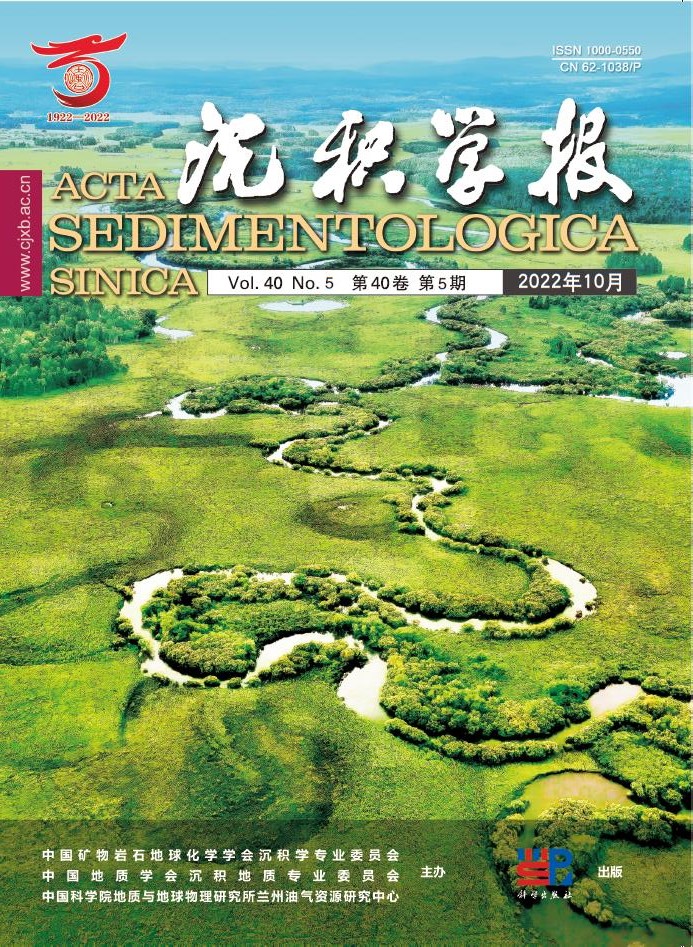


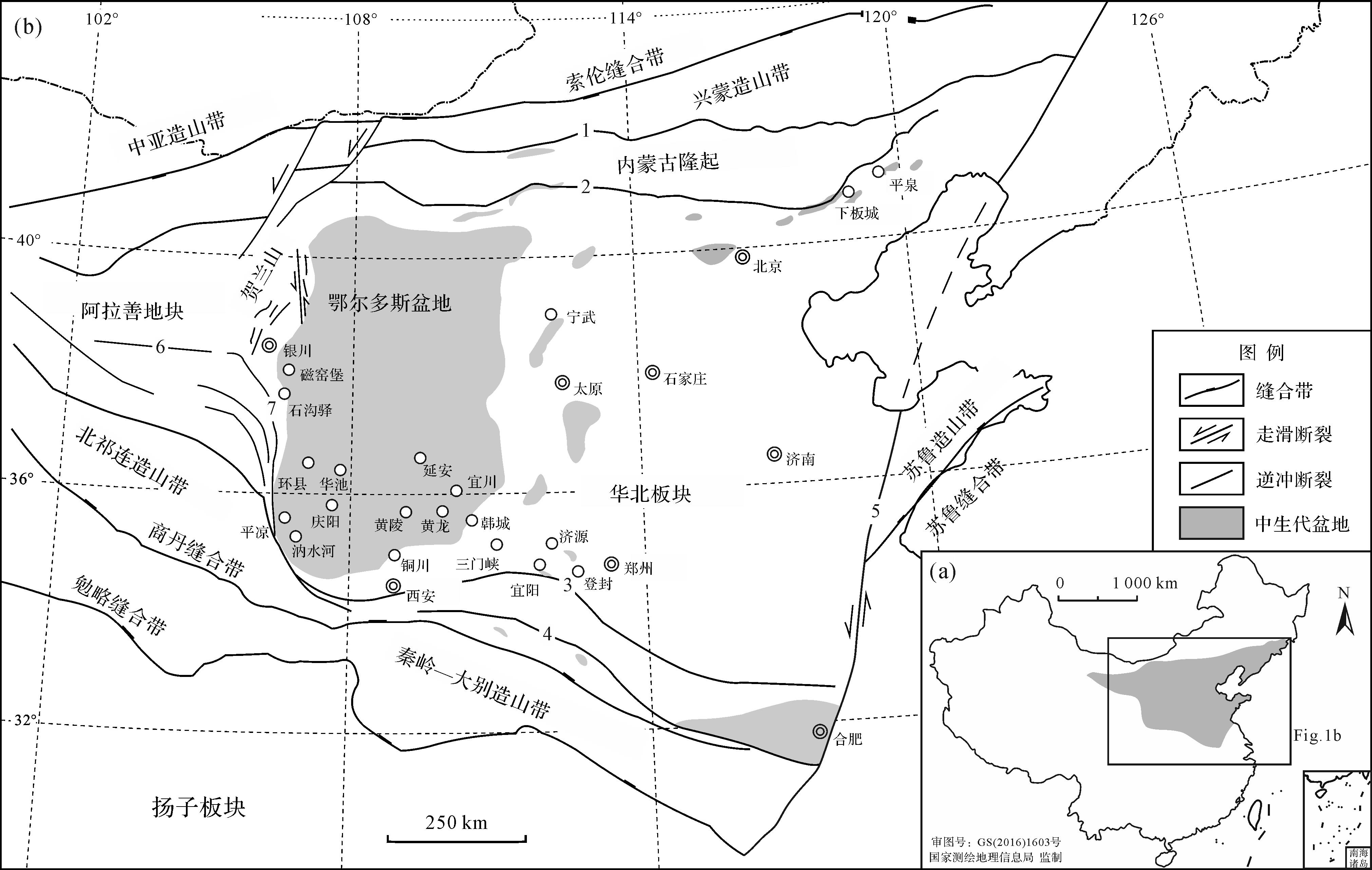






 DownLoad:
DownLoad:
